Hair
| Hair | |
|---|---|
Scanning electron microscopy image of Merino wool (top) and human hair (bottom) showing keratin scales | |
| Details | |
| System | Integumentary system |
| Identifiers | |
| Latin | capillum |
| MeSH | D006197 |
| TA98 | A16.0.00.014 |
| TA2 | 7053 |
| TH | H3.12.00.3.02001 |
| FMA | 53667 |
| Anatomical terminology] | |
Hair is a protein filament that grows from follicles found in the dermis. Hair is one of the defining characteristics of mammals. The
Attitudes towards different forms of hair, such as hairstyles and hair removal, vary widely across different cultures and historical periods, but it is often used to indicate a person's personal beliefs or social position, such as their age, gender, or religion.[1]
Overview

The word "hair" usually refers to two distinct structures:
- the part beneath the skin, called the hair follicle, or, when pulled from the skin, the bulb or root. This organ is located in the dermis and maintains stem cells, which not only re-grow the hair after it falls out, but also are recruited to regrow skin after a wound.[2]
- the hair shaft, which is the hard filamentous part that extends above the skin surface. A cross section of the hair shaft may be divided roughly into three zones.
Hair fibers have a structure consisting of several layers, starting from the outside:
- the cuticle, which consists of several layers of flat, thin cells laid out overlapping one another as roof shingles
- the cortex, which contains the keratin bundles in cell structures that remain roughly rod-like
- the medulla, a disorganized and open area at the fiber's center[3]
Description
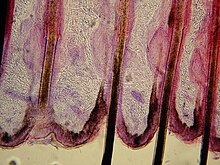
Each strand of hair is made up of the
Hair growth begins inside the
Root of the hair
| Root of the hair | |
|---|---|
sebaceous glands. | |
| Details | |
| Identifiers | |
| Latin | radix pili |
| MeSH | D006197 |
| TA98 | A16.0.00.014 |
| TA2 | 7053 |
| TH | H3.12.00.3.02001 |
| FMA | 53667 |
| Anatomical terminology] | |
The root of the hair ends in an enlargement, the hair bulb, which is whiter in color and softer in texture than the shaft and is lodged in a follicular involution of the
Natural color
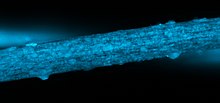

All natural hair colors are the result of two types of hair pigments. Both of these pigments are melanin types, produced inside the hair follicle and packed into granules found in the fibers.
Human hair growth
Hair grows everywhere on the external body except for mucus membranes and glabrous skin, such as that found on the palms of the hands, soles of the feet, and lips.
The body has different types of hair, including


The three stages of hair growth are the anagen, catagen, and telogen phases. Each strand of hair on the human body is at its own stage of development. Once the cycle is complete, it restarts and a new strand of hair begins to form. The growth rate of hair varies from individual to individual depending on their age, genetic predisposition and a number of environmental factors.[11] It is commonly stated that hair grows about 1 cm per month on average; however reality is more complex, since not all hair grows at once. Scalp hair was reported to grow between 0.6 cm and 3.36 cm per month. The growth rate of scalp hair somewhat depends on age (hair tends to grow more slowly with age), sex, and ethnicity.[12] Thicker hair (>60 µm) grows generally faster (11.4 mm per month) than thinner (20-30 µm) hair (7.6 mm per month).[13][14]
It was previously thought that Caucasian hair grew more quickly than Asian hair and that the growth rate of women's hair was faster than that of men.
The world record for longest hair on a living person stands with Smita Srivastava of Uttar Pradesh, India. At 7 feet and 9 inches long, she broke a Guinness World Record in November 2023, having grown her hair for 32 years.[22]
Texture

Hair exists in a variety of textures. Three main aspects of hair texture are the curl pattern, volume, and consistency. All mammalian hair is composed of
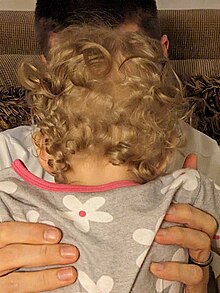
The flatter the hair shaft becomes, the curlier hair gets, because the shape allows more cysteines to become compacted together resulting in a bent shape that, with every additional disulfide bond, becomes curlier in form.[23] As the hair follicle shape determines curl pattern, the hair follicle size determines thickness. While the circumference of the hair follicle expands, so does the thickness of the hair follicle. An individual's hair volume, as a result, can be thin, normal, or thick. The consistency of hair can almost always be grouped into three categories: fine, medium, and coarse. This trait is determined by the hair follicle volume and the condition of the strand.[24] Fine hair has the smallest circumference, coarse hair has the largest circumference, and medium hair is anywhere between the other two.[24] Coarse hair has a more open cuticle than thin or medium hair causing it to be the most porous.[24]
Classification systems
There are various systems that people use to classify their curl patterns. Being knowledgeable of an individual's hair type is a good start to knowing how to take care of one's hair. There is not just one method to discovering one's hair type. Additionally it is possible, and quite normal to have more than one kind of hair type, for instance having a mixture of both type 3a & 3b curls.
- Andre Walker system
The Andre Walker Hair Typing System is the most widely used system to classify hair. The system was created by the hairstylist of Oprah Winfrey, Andre Walker. According to this system there are four types of hair: straight, wavy, curly, kinky.
- Type 1 is straight hair, which reflects the most sheen and also the most resilient hair of all of the hair types. It is hard to damage and immensely difficult to curl this hair texture. Because the sebumeasily spreads from the scalp to the ends without curls or kinks to interrupt its path, it is the most oily hair texture of all.
- Type 2 is wavy hair, whose texture and sheen ranges somewhere between straight and curly hair. Wavy hair is also more likely to become frizzy than straight hair. While type A waves can easily alternate between straight and curly styles, type B and C Wavy hair is resistant to styling.
- Type 3 is curly hair known to have an S-shape. The curl pattern may resemble a lowercase "s", uppercase "S", or sometimes an uppercase "Z" or lowercase "z". [citation needed] Lack of proper care causes less defined curls.
- Type 4 is kinky hair, which features a tightly coiled curl pattern (or no discernible curl pattern at all) that is often fragile with a very high density. This type of hair shrinks when wet and because it has fewer cuticle layers than other hair types it is more susceptible to damage.
| Type 1: Straight | ||
|---|---|---|
| 1a | Straight (Fine/Thin) | Hair tends to be very soft, thin, shiny, oily, poor at holding curls, difficult to damage. |
| 1b | Straight (Medium) | Hair characterized by volume and body. |
| 1c | Straight (Coarse) | Hair tends to be bone-straight, coarse, difficult to curl. |
| Type 2: Wavy | ||
| 2a | Wavy (Fine/Thin) | Hair has definite "S" pattern, can easily be straightened or curled, usually receptive to a variety of styles. |
| 2b | Wavy (Medium) | Can tend to be frizzy and a little resistant to styling. |
| 2c | Wavy (Coarse) | Fairly coarse, frizzy or very frizzy with thicker waves, often more resistant to styling. |
| Type 3: Curly | ||
| 3a | Curly (Loose) | Presents a definite "S" pattern, tends to combine thickness, volume, and/or frizziness. |
| 3b | Curly (Tight) | Presents a definite "S" pattern, curls ranging from spirals to spiral-shaped corkscrew |
| Type 4: Kinky | ||
| 4a | Kinky (Soft) | Hair tends to be very wiry and fragile, tightly coiled and can feature curly patterning. |
| 4b | Kinky (Wiry) | As 4a but with less defined pattern of curls, looks more like a "Z" with sharp angles |
- FIA system
This is a method which classifies the hair by curl pattern, hair-strand thickness and overall hair volume.
|
Curliness | ||
|---|---|---|
| Straight | ||
| 1a | Stick-straight. | |
| 1b | Straight but with a slight body wave adding some volume. | |
| 1c | Straight with body wave and one or two visible S-waves (e.g. at nape of neck or temples). | |
| Wavy | ||
| 2a | Loose with stretched S-waves throughout. | |
| 2b | Shorter with more distinct S-waves (resembling e.g. braided damp hair). | |
| 2c | Distinct S-waves, some spiral curling. | |
| Curly | ||
| 3a | Big, loose spiral curls. | |
| 3b | Bouncy ringlets. | |
| 3c | Tight corkscrews. | |
| Very ("Really") curly | ||
| 4a | Tightly coiled S-curls. | |
| 4b | Z-patterned (tightly coiled, sharply angled) | |
| 4c | Mostly Z-patterned (tightly kinked, less definition) | |
|
Strands | ||
| F | Fine
Thin strands that sometimes are almost translucent when held up to the light. | |
| M | Medium
Strands are neither fine nor coarse. | |
| C | Coarse
Thick strands whose shed strands usually are easily identified. | |
| Volume by circumference of full-hair ponytail | ||
| i | Thin | Circumference less than 2 inches (5 centimetres) |
| ii | Normal | ... from 2 to 4 inches (5 to 10 centimetres) |
| iii | Thick | ... more than 4 inches (10 centimetres) |
Composition
Hair is mainly composed of keratin proteins and keratin-associated proteins (KRTAPs). The human genome encodes 54 different keratin proteins which are present in various amounts in hair. Similarly, humans encode more than 100 different KRTAPs which crosslink keratins in hair. The content of KRTAPs ranges from less than 3% in human hair to 30–40% in echidna quill.[25]
Functions
Many mammals have fur and other hairs that serve different functions. Hair provides thermal regulation and camouflage for many animals; for others it provides signals to other animals such as warnings, mating, or other communicative displays; and for some animals hair provides defensive functions and, rarely, even offensive protection. Hair also has a sensory function, extending the sense of touch beyond the surface of the skin. Guard hairs give warnings that may trigger a recoiling reaction.
Warmth

While humans have developed clothing and other means of keeping warm, the hair found on the head serves primarily as a source of heat
Protection
In some mammals, such as hedgehogs and porcupines, the hairs have been modified into hard spines or quills. These are covered with thick plates of keratin and serve as protection against predators. Thick hair such as that of the lion's mane and grizzly bear's fur do offer some protection from physical damages such as bites and scratches.
Touch sense
Displacement and vibration of hair shafts are detected by hair follicle nerve receptors and nerve receptors within the skin. Hairs can sense movements of air as well as touch by physical objects and they provide sensory awareness of the presence of

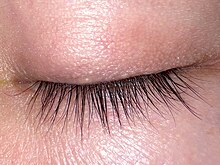
Eyebrows and eyelashes
The
The
Eyebrows and eyelashes do not grow beyond a certain length (eyelashes are rarely more than 10 mm long). However, trichomegaly can cause the lashes to grow remarkably long and prominent (in some cases the upper lashes grow to 15 mm long).
Evolution
Hair has its origins in the common ancestor of mammals, the
Some modern mammals have a special gland in front of each orbit used to preen the fur, called the harderian gland. Imprints of this structure are found in the skull of the small early mammals like Morganucodon, but not in their cynodont ancestors like Thrinaxodon.[39]
The hairs of the fur in modern animals are all connected to nerves, and so the fur also serves as a transmitter for sensory input. Fur could have evolved from sensory hair (whiskers). The signals from this sensory apparatus is interpreted in the
The high interspecific variability of the size, color, and microstructure of hair often enables the identification of species based on single hair filaments.[43][44]
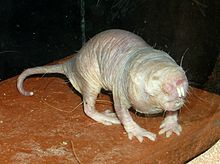
In varying degrees most
.The naked mole-rat (Heterocephalus glaber) has evolved skin lacking in general, pelagic hair covering, yet has retained long, very sparsely scattered tactile hairs over its body.[45] Glabrousness is a trait that may be associated with neoteny.[47]
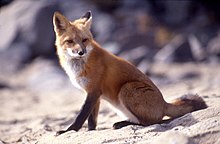
Human hairlessness
Evolutionary variation
Primates are relatively hairless compared to other mammals, and
Another factor in human evolution that also occurred in the prehistoric past was a preferential selection for
Texture
Curly hair


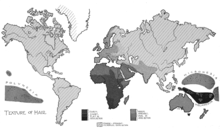
This section needs additional citations for verification. (August 2016) |
Jablonski
It is substantiated by Iyengar's findings (1998) that UV light can enter into straight human hair roots (and thus into the body through the skin) via the hair shaft. Specifically, the results of that study suggest that this phenomenon resembles the passage of light through fiber optic tubes (which do not function as effectively when kinked or sharply curved or coiled). In this sense, when hominids (i.e. Homo erectus) were gradually losing their straight body hair and thereby exposing the initially pale skin underneath their fur to the sun, straight hair would have been an adaptive liability. By inverse logic, later, as humans traveled farther from Africa and/or the equator, straight hair may have (initially) evolved to aid the entry of UV light into the body during the transition from dark, UV-protected skin to paler skin.
Jablonski's assertions[52] suggest that the adjective "woolly" in reference to Afro-hair is a misnomer in connoting the high heat insulation derivable from the true wool of sheep. Instead, the relatively sparse density of Afro-hair, combined with its springy coils actually results in an airy, almost sponge-like structure that in turn, Jablonski argues,[52] more likely facilitates an increase in the circulation of cool air onto the scalp. Further, wet Afro-hair does not stick to the neck and scalp unless totally drenched and instead tends to retain its basic springy puffiness because it less easily responds to moisture and sweat than straight hair does. In this sense, the trait may enhance comfort levels in intense equatorial climates more than straight hair (which, on the other hand, tends to naturally fall over the ears and neck to a degree that provides slightly enhanced comfort levels in cold climates relative to tightly coiled hair).
Further, it is notable that the most pervasive expression of this hair texture can be found in sub-Saharan Africa; a region of the world that abundant genetic and paleo-anthropological evidence suggests, was the relatively recent (≈200,000-year-old) point of origin for modern humanity. In fact, although genetic findings (Tishkoff, 2009) suggest that sub-Saharan Africans are the most genetically diverse continental group on Earth,
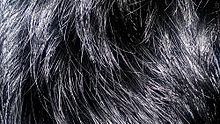
The EDAR locus
A group of studies have recently shown that genetic patterns at the EDAR locus, a region of the modern human genome that contributes to hair texture variation among most individuals of East Asian descent, support the hypothesis that (East Asian) straight hair likely developed in this branch of the modern human lineage subsequent to the original expression of tightly coiled
Specifically, the relevant findings indicate that the EDAR mutation coding for the predominant East Asian 'coarse' or thick, straight hair texture arose within the past ≈65,000 years, which is a time frame that covers from the earliest of the 'Out of Africa' migrations up to now.Disease
Premature greying of hair is another condition that results in greying before the age of 20 years in Europeans, before 25 years in Asians, and before 30 years in Africans.[60]
Hair care
Hair care involves the hygiene and cosmetology of hair including hair on the scalp, facial hair (beard and moustache), pubic hair and other body hair. Hair care routines differ according to an individual's culture and the physical characteristics of one's hair. Hair may be colored, trimmed, shaved, plucked, or otherwise removed with treatments such as waxing, sugaring, and threading.
Removal practices
Shaving
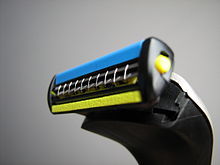
Waxing
Waxing involves using a sticky wax and strip of paper or cloth to pull hair from the root. Waxing is the ideal hair removal technique to keep an area hair-free for long periods of time. It can take three to five weeks for waxed hair to begin to resurface again. Hair in areas that have been waxed consistently is known to grow back finer and thinner, especially compared to hair that has been shaved with a razor.
Laser removal
Laser hair removal is a cosmetic method where a small laser beam pulses selective heat on dark target matter in the area that causes hair growth without harming the skin tissue. This process is repeated several times over the course of many months to a couple of years with hair regrowing less frequently until it finally stops; this is used as a more permanent solution to waxing or shaving. Laser removal is practiced in many clinics along with many at-home products.
Cutting and trimming
Because the hair on one's head is normally longer than other types of body hair, it is cut with
Cut hair may be used in wigs. Global imports of hair in 2010 was worth $US 1.24 billion.[61]
Social role
Hair has great social significance for
The world's longest documented hair belongs to Xie Qiuping (in China), at 5.627 m (18 ft 5.54 in) when measured on 8 May 2004. She has been growing her hair since 1973, from the age of 13.[64]
Indication of status
Healthy hair indicates health and youth (important in
A hairstyle may be an indicator of group membership. During the English Civil War, followers of Oliver Cromwell cropped their hair close to their head in an act of defiance against the curls and ringlets of the king's men, which led to them being nicknamed Roundheads.[65] Recent isotopic analysis of hair is helping to shed further light on sociocultural interaction, giving information on food procurement and consumption in the 19th century.[66] Having bobbed hair was popular among the flappers in the 1920s as a sign of rebellion against traditional roles for women. Female art students known as the Cropheads also adopted the style, notably at the Slade School in London. Regional variations in hirsutism has caused practices regarding hair on the arms and legs to differ. Some religious groups may follow certain rules regarding hair as part of religious observance. The rules often differ for men and women.
Many subcultures have hairstyles which may indicate an unofficial membership. Many
Heads were shaved in
In the time of Confucius (5th century BCE), the Chinese grew out their hair and often tied it, as a symbol of filial piety. Regular hairdressing in some cultures is considered a sign of wealth or status. The
Tightly coiled hair in its natural state may be worn in an
The film
Religious practices
Women's hair may be hidden using
In Arabic poetry
Since ancient times, women's long, thick, wavy hair has featured prominently in
See also
- List of hairstyles
- Body hair
- Chaetophobia– the fear of hair
- Hair analysis (alternative medicine)
- Hypertrichosis – the state of having an excess of hair on the head or body
- Hypotrichosis– the state of having a less than normal amount of hair on the head or body
- Lanugo
- Seta – hair-like structures in insects
- Bristle sensilla – tactile hairs in insects
- Trichotillomania – hair pulling
References
Citations
- ISBN 978-0-313-33145-9.
- PMID 16616298.
- ISBN 978-0-86840-359-5. Retrieved 27 January 2016.
- ^ a b Hair Structure and Hair Life Cycle. follicle.com
- ^ "Topic 2". Texascollaborative.org. Archived from the original on 15 April 2013. Retrieved 18 February 2015.
- ^ a b Bisbing, Richard E. "3. The Forensic Identification and Association of Human Hair". In Saferstein, Richard; Hall, Adam B. (eds.). Forensic Science Handbook. Vol. 1 (3rd ed.). CRC Press. pp. 165-166. Archived (pp. 165, 166) on 18 April 2023.
- ^ Ley, Brian (1999). "Diameter of a Human Hair". Retrieved 28 June 2010.
- ^ Councilman, W. T. (1913). "Ch. 1". Disease and Its Causes. United States: New York Henry Holt and Company London Williams and Norgate The University Press, Cambridge, USA.
- ISBN 9781850700067.
- ^ Histology Guide | Skin Histology.leeds.ac.uk. Retrieved on 18 May 2016.
- PMID 19211055.
- ^ PMID 8138238.
- S2CID 19060270.
- S2CID 1310059.
- ^ Joseph Castro (27 January 2014). "How Fast Does Hair Grow?". Live Science. Retrieved 3 July 2020.
- S2CID 39103960.
- ^ "How many hairs are on a human head in total and per square inch?". curlcentric.com. Retrieved 18 April 2022.
- ^ "Number of hairs on human head". harvard.edu. Archived from the original on 14 December 2021. Retrieved 18 April 2022.
- ^ "How much hair does a human have on their head?". mevolife.com. Retrieved 18 April 2022.
- ^ "Do your hair and fingernails grow after death?". bbc.com. Retrieved 18 April 2022.
- ISBN 978-3-642-02201-2.
- ^ "UP woman, 46, sets world record with 7 ft 9 in long hair". Hindustan Times. 30 November 2023. Retrieved 30 November 2023.
- ^ a b "Curly Hair Gene". Bio.davidson.edu. Retrieved 28 January 2015.
- ^ a b c "Hair type, texture and density | Hairdressing Training". Hairdressing.ac.uk. Archived from the original on 12 February 2015. Retrieved 28 January 2015.
- PMID 29797267, retrieved 4 March 2023
- ^ Bubenik, George A. (1 September 2003). "Why do humans get "goosebumps" when they are cold, or under other circumstances?". Scientific American. Retrieved 4 May 2010.
- PMID 22171023.
- ^ "Neuroscience for Kids – Receptors". Faculty.washington.edu. Retrieved 18 February 2015.
- ^ "hair biology – functions of the hair fiber and hair follicle". Keratin.com. Archived from the original on 30 March 2017. Retrieved 18 February 2015.
- PMID 4811387.
- .
- ^ "Images of Nature". Ion.asu.edu. Archived from the original on 8 May 2006. Retrieved 18 February 2015.
- S2CID 129567176.
- ^ Kardong, K.V. (2002): Vertebrates: Comparative anatomy, function, evolution. 3rd Edition. McGraw-Hill, New York
- S2CID 46067702. See also the news item at "Jurassic "Beaver" Found; Rewrites History of Mammals". Archived from the originalon 22 September 2012. Retrieved 12 August 2012.
- ^ "Jurassic squirrel's secret is out". The Hindu. 9 August 2013. Retrieved 29 June 2016.
- S2CID 205259206.
- .
- ISBN 978-3-642-53748-6.
- S2CID 940501.
- .
- ^ Plower, R.P. (1897). An introduction to the study of mammals living and extinct. New York: Cornell University Library. p. 11. Retrieved 8 June 2012.
Flat scutes, with the edges in apposition, and not overlaid, clothe both surfaces of the tail of the beaver, rats, and others of the same order, and also of some insectivores and marsupials.
- ISBN 9780521545778.
- ISBN 978-963-88339-7-6. Retrieved 8 July 2019.
- ^ )
- ISBN 978-0241184035.)
{{cite book}}: CS1 maint: multiple names: authors list (link - S2CID 21484729.
- PMID 23900811.
- PMID 32241925.
- PMID 21489604.
- PMID 22160694.
- ^ ISBN 978-0-520-94170-0. Retrieved 27 January 2016.
- ^ Bolk, L. (1926). Das Problem der Menschwerdung (in German). Jena: Fischer.
- ISBN 0674639413.
- PMID 25246593.
- PMID 18065779.
- S2CID 20084816. Archived from the original(PDF) on 5 February 2011. Retrieved 14 December 2010.
- S2CID 37696013. Retrieved 30 January 2019.
- ^ "Dermatologyinfo.net". Dermatologyinfo.net. Retrieved 21 May 2012.
- PMID 23974581. Retrieved 15 November 2017.
- .
- doi:10.11141/ia.42.6.
- .
- ISBN 9781904994572.
- ISBN 0-684-80164-7
- .
- OCLC 1199967093.)
{{cite book}}: CS1 maint: location missing publisher (link - OCLC 1249505982.)
{{cite book}}: CS1 maint: location missing publisher (link - OCLC 1223027644.
- )
- ISBN 0-7126-6523-4.
- ^ "G1 – Justiça do CE condena escola por barrar aluno com cabelo 'moicano' – notícias em Ceará" [G1 - CE court condemns school for barring student with 'mohawk' hair - news in Ceara]. G1.globo.com. 28 September 2011. Retrieved 18 February 2015.
- ^ "G1 – Aluno diz que jogador inspirou 'corte moicano' alvo de ação judicial no CE – notícias em Ceará" [G1 says student inspired 'Mohawk court' subject to legal action in CE - news in Ceara]. G1.globo.com. 30 September 2011. Retrieved 18 February 2015.
- ^ Dilgeer, Harjinder Singh (2005) Dictionary of Sikh Philosophy, Sikh University Press.
- ^ The War Within Our Hearts – Page 65 Sa'ad Quadri – 2013
- ^ ISBN 90-04-10422-4. Retrieved 13 June 2022.
Sources
- Iyengar, B. (1998). "The hair follicle is a specialized UV receptor in human skin?". Bio Signals Recep. 7 (3): 188–194. S2CID 46864921.
- Jablonski, N.G. (2006). Skin: a natural history. Berkeley, CA: University of California Press.
- Rogers, Alan R.; Iltis, David; Wooding, Stephen (2004). "Genetic variation at the MC1R locus and the time since loss of human body hair". Current Anthropology. 45 (1): 105–108. S2CID 224795768.
- Tishkoff, S. A.; Dietzsch, E.; Speed, W.; Pakstis, A. J.; Kidd, J. R.; Cheung, K.; Bonne-Tamir, B.; Santachiara-Benerecetti, A. S.; et al. (1996). "Global patterns of linkage disequilibrium at the CD4 locus and modern human origins". Science. 271 (5254): 1380–1387. S2CID 4266475.
External links
 Quotations related to Hair at Wikiquote
Quotations related to Hair at Wikiquote The dictionary definition of hair at Wiktionary
The dictionary definition of hair at Wiktionary- How to measure the diameter of your own hair using a laser pointer
- Instant insight outlining the chemistry of hair from the Royal Society of Chemistry
- PUIU, TIBI (23 August 2018). "How fast hair grows, and other hairy science". ZME Science. Retrieved 30 August 2018.
